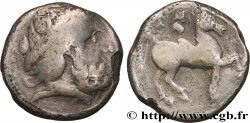Live auction - bga_733840 - DANUBIAN CELTS - IMITATIONS OF THE TETRADRACHMS OF PHILIP II AND HIS SUCCESSORS Tétradrachme “au monogramme d’Audoléon”
You must signin and be an approved bidder to bid, LOGIN TO BID. Accounts are subject to approval and the approval process takes place within 48 hours. Do not wait until the day a sale closes to register. Clicking on "BID" constitutes acceptance of the terms of use of cgb.fr private live auctions.
Bids must be placed in whole Euro amounts only. The sale will start closing at the time stated on the item description; any bids received at the site after the closing time will not be executed. Transmission times may vary and bids could be rejected if you wait until the last second. For further information check the Live auction FAQ
All winning bids are subject to a 18% buyer’s fee.
All winning bids are subject to a 18% buyer’s fee.
| Estimate : | 1 500 € |
| Price : | 870 € |
| Maximum bid : | 1 000 € |
| End of the sale : | 26 July 2022 16:07:39 |
| bidders : | 3 bidders |
Type : Tétradrachme “au monogramme d’Audoléon”
Date: c. IIe-Ier siècles AC.
Metal : silver
Diameter : 21,5 mm
Orientation dies : 6 h.
Weight : 13,48 g.
Rarity : R2
Coments on the condition:
Monnaie idéalement centrée, avec de très jolis détails au droit comme au revers. Iconographie bien venue lors de la frappe, une très belle patine grise
Obverse
Obverse legend : ANÉPIGRAPHE.
Obverse description : Tête barbare, laurée et barbue de Zeus à droite.
Reverse
Reverse legend : ANÉPIGRAPHE.
Reverse description : Cavalier très stylisé, sur un cheval plus réaliste ; une volute devant le poitrail, une esse bouletée sous la jambe gauche du cheval et un fleuron sous le ventre.
Commentary
Sur ce type, la couronne de laurier est très importante d'où l'appellation de "Verkehrten Lorbeerkranz". Elle est de plus perlée aux extrémités, visible sur notre exemplaire au-dessus du front. Au revers, outre le monogramme, nous avons deux symboles énigmatiques, l'esse bouletée entre les antérieurs du cheval et la volute devant le poitrail.








 Report a mistake
Report a mistake Print the page
Print the page Share my selection
Share my selection Ask a question
Ask a question Consign / sell
Consign / sell
 Full data
Full data















